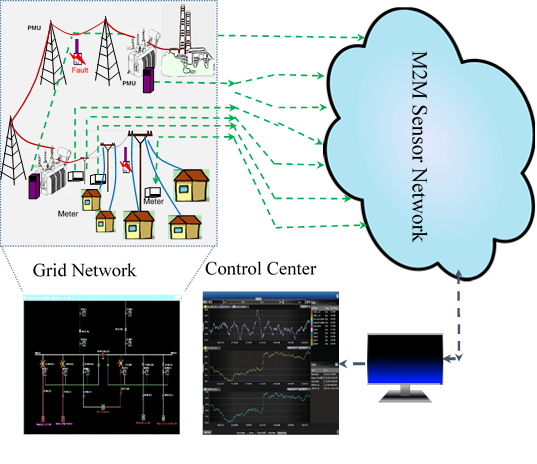Summary
The Smart Grid can be defined as an electric system that uses information, two-way, cyber-secure communication technologies, and computational intelligence in an integrated fashion across the entire spectrum of the energy system from the generation to the end points of consumption. The availability of new technologies such as distributed sensors, two-way secure communications, advanced software for data management, and intelligent and autonomous controllers have opened up new opportunities for changing the energy system. The main objective is to develop a measurement science toward communication networking with the specific aim of strengthening modeling capabilities and determining the potential impact on critical infrastructure.
Description
Currently, the Smart Grid faces challenges in terms of reliability and security in both wired and wireless communication environments. The most important challenge is a lack of communication network infrastructure, which is a key factor in supporting the grid monitoring system. In the absence of any infrastructure network, wireless is often viewed as the most cost effective alternative to the wirelines communications. Recently, there has been a tremendous effort in promoting the wireless based 'Internet of Things' (IoT), or simply 'Machine to Machine' (M2M) communication for wide ranging sensory devices. In particular, grid monitoring is one of the key elements of critical infrastructure resilience. An important aspect of grid monitoring is outage management that could prevent a cascading failure in the grid network. Nowadays, with the ever increasing deployment of Phasor Measurement Units (PMU’s), the dynamic is shifting towards situational awareness through a wide area measurement system.
The smart grid projects focus primarily on leveraging the synchronized current/voltage amplitudes and phase angles measurements to foster new categories of applications and standards to improve the effectiveness of grid protection and minimize outage duration. The motivation for such an application arises from the fact that with the support of communication, synchronized measurements from multiple sites in the grid network can greatly enhance the accuracy and timeliness of identifying the source of instabilities. ANTD in collaboration with the Engineering Laboratory has been engaged in research and development towards promoting interoperable communication networking protocols for smart grid. The main areas of activities are:
- Combined Grid communication Testbed Implementation for Real-time Measurement, Calibration, and Communication
- Synchrophasor Networks for Grid Monitoring
- Power Quality Measurement and Fault Detection and Identification
- Wireless network access and security
- Neighborhood area communication network
- Collaborative Microgrid for Smart Buildings
- Wireless M2M Network For Power Grid
- State Estimation for Uncertain Power Systems
- Spectrum Tracking in Power Grid System

Major Accomplishments
By setting a new performance benchmark for future research, these projects are expected to have a significant impact on the wireless networking community. Another major accomplishment is that the framework and tools introduced are generic; expandable to other applications and can therefore serve as useful vehicles in the design of future generations of grid and wireless communication networking platforms. The introduction of these techniques and a detailed experimentation methodology have already been published in prestigious journals and conferences and will be valuable to both researchers and practitioners in smart grid networking.

